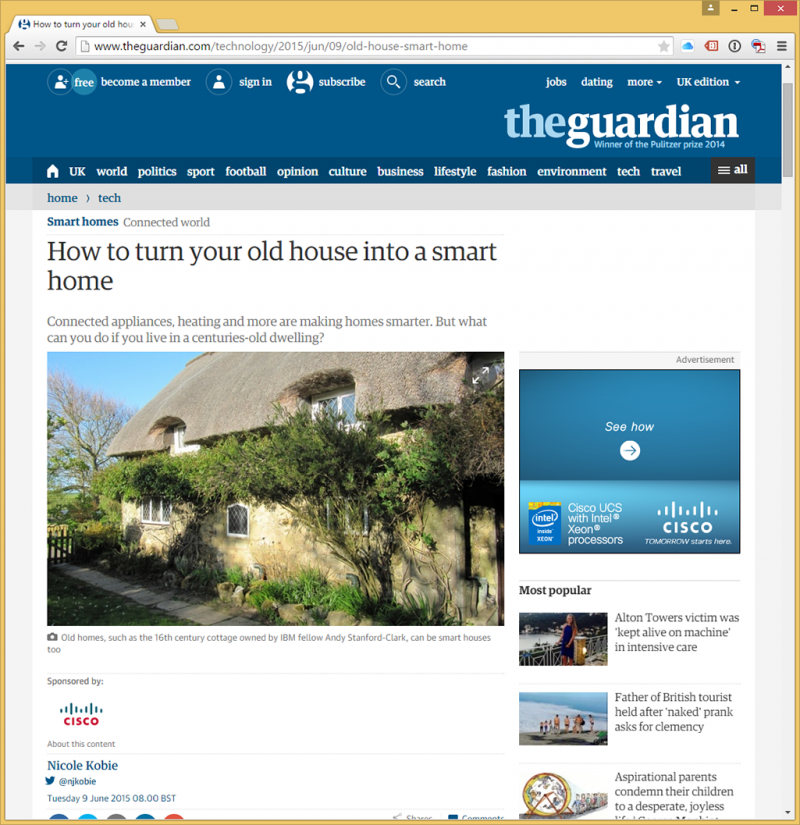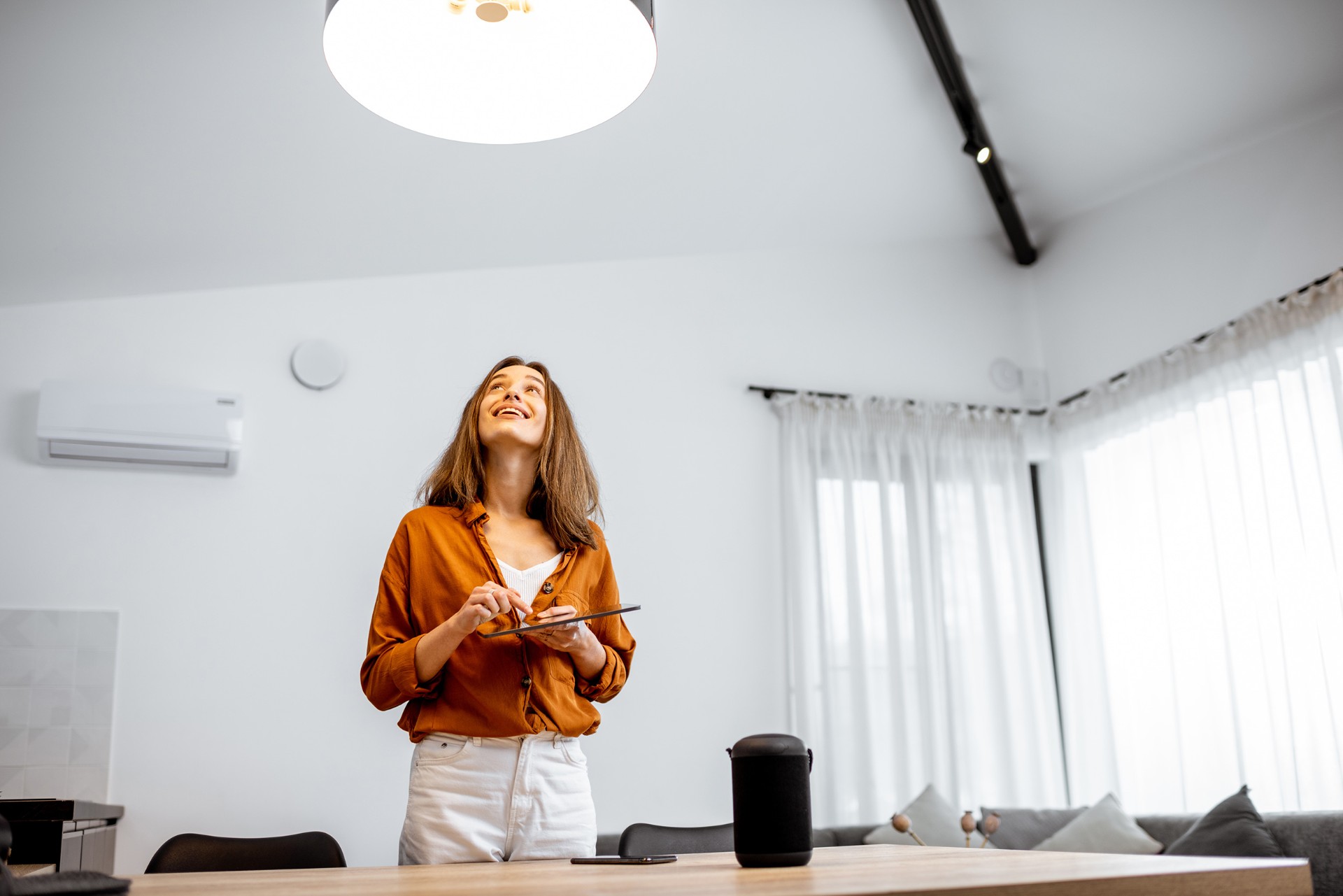20.06.2023
Transform your Cyberhomes Home Cinema with a Star Ceiling
Adding a Cyberhomes home cinema room is a dream come true for movie en...
Smart home technologies mean your heating comes on at the right time, you can manage your lights from a smartphone, and your dishwasher sends you text messages.
You don’t need to build a new house from the ground up to benefit from the internet of things (IoT) in your home, but older buildings can be more of a challenge than newer residences.
That 500-year-old house with thick stone walls is certainly beautiful, but good luck getting Wi-Fi signal to every charming corner; that Nest smart home heating system sure is spiffy, but it doesn’t work with the storage heater in your 40-year-old flat. For help, we turned to Andy Stanford-Clark.
He’s a fellow at IBM, heading up its IoT department, but it’s his hobby we’re speaking about. Stanford-Clark lives in a 16th century detached cottage that despite its age is possibly the UK’s smartest home.

His windows have sensors that send an alert if they’re open when he leaves home, the fish pond fountain checks if it’s windy before turning on, his mousetraps alert when they’ve been triggered, and there’s even an automated heated towel rail that checks his Google calendar to see if he’s away to save energy.
When he turns on his dishwasher, it texts him if it’s a high-use time, and therefore expensive for electricity, asking if the dishes can wait. He can reply by text. Not bad for a thatched-roof cottage older than the country that is home to Silicon Valley.
When transforming an older house into a smart home, it usually makes more sense to use wireless technology than wires, Stanford-Clark advises.
“But with a house like ours you get problems with radio range, because the Wi-Fi doesn’t reach all the way down to the end of the house, because the thick stone walls are absorbing the signal. So you have to use something like mesh-connected radio.”
“Each sensor can see one other sensor,” he explains. “
Mesh controllers such as ZigBee or Z-Wave not only offer good coverage, but devices using the communications system draw little power; however, there’s issues of interoperability. Either way, using such a system means you don’t need perfect Wi-Fi coverage.
Andy Mack, director of Cyberhomes, disagrees on wireless, saying it is best to wire up as much as possible, especially for devices in a fixed location.
When building a smart home from scratch, the sensors and controllers can be built into the walls, but if you’re retrofitting, you’ll need to “put things on the walls rather than in the walls,” Stanford-Clark notes.
If you have renovations planned, Mack suggests considering installing smart features. “If you’re stripping plaster off the walls, maybe consider whether you want to put some wires in there while you’re at it,” he said.
He notes that smart lighting systems can be installed at the wall plate, which can be modified to look like a traditional switch.
Smart energy meters and home heating systems are the most popular IoT device in Britain, according to Bergin Insight.
Hive is one smart meter company whose devices are supplied by British Gas. A spokeswoman says it is possible to connect its sensors to any heating system – gas, oil or electric – but not storage heaters.
Even then there are options to smarten it up – and that includes those who rent. Stanford-Clark pointed out you can buy an adaptor that sits between the wall socket and the plug of your appliance. “It’s rather like switching the switch on the wall on or off remotely,” he explains.
That means you can turn your storage heater on the day before returning from a long trip away so you come back to a warm house, or tell a fan heater to start up in the kitchen before getting out of bed. Such a system can get even smarter with the inclusion of a temperature gauge: using a simple system such as If This Then That, you can easily programme a heater to go on at a certain temperature – and do much more.
“One of my computers could take the decision to turn it on for me,” explains Stanford-Clark. It detects from the GPS in his smartphone that he is 15 minutes away from home and turns on the heating.
The difficulty with older homes is the rooms often vary in temperature. The trick to that is to have smart heating sensors not only monitoring how cold it is in each room, but checking the external temperature, whether from weather websites or a sensor outside.

Smart homes can be very simple and easy, but that means they are likely to be limited. They can also be super smart and fully automated, but therefore complicated.
For example, it’s simple to add smart lighting to a home, regardless of its age. Buy a Philips hue bulb, screw it into a socket, download the app and you’re ready to go – however, a pack of three bulbs costs £149. If all you want is your front lighting to come on when you get home, that may well be all you need.
If you want to try smart lights as well as switches to turn appliances on and off, consider a system such as Belkin’s WeMo or D-Link’s mydlink. Again, you’ll have to shell out for a switch or bulb for each “smart” addition to your home, but it’s simple to install – simply plug your floor heater into the WeMo device, and plug that into your wall socket.
LightwaveRF takes it a step further – its smart sockets and switches directly replace the ones in your home, letting you control anything that plugs in.
Stanford-Clark uses the Raspberry Pi, a cheap and easy computing board, as the brains behind his operation. You’ll need to be a bit handy and have a willingness to try programming, but websites such as If This Then That make it simpler.
“A lot of things are in their early stages. But what makes it possible is that you can buy these things like a home heating controller, a Hive or a Nest or something like that, which comes with its own applications,” he says.
That means it has its own smart system that works in the cloud, and its own app that you use to control it. “The disadvantage is, it doesn’t integrate with all your other things,” said Stanford-Clark. “ But those things will come.”
Indeed, it could be set to get a lot easier with the advent of smart-home systems from Apple and Google. If you have an iPhone and buy devices running Apple’s HomeKit, due later this year, they’ll be able to interact with each other – the same follows for Google’s newly announced Brillo.
The next year will be key for smart home platforms, so it may well be worth waiting for the internet of things to get a bit smarter and simpler before installing it in your home.
Author: Nicole Kobie @njkobie
The Guardian